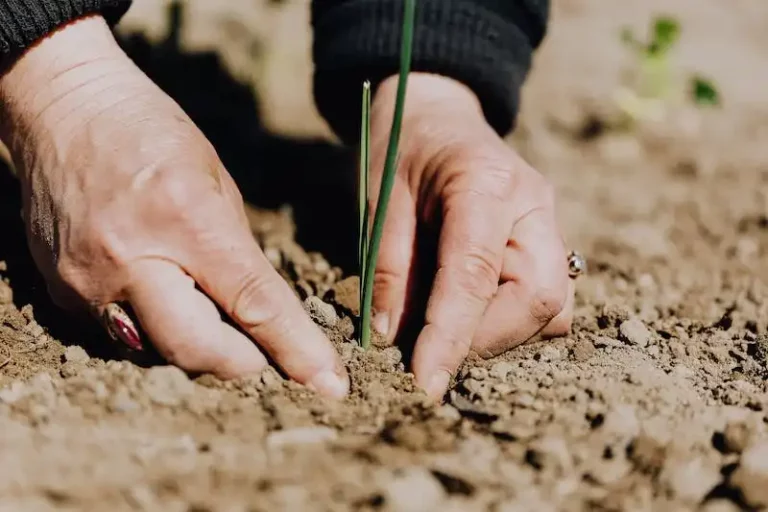Planting an oak tree from an acorn can bring many benefits to your home and landscape. Not only are oak trees beautiful and majestic, but they also provide shade, act as a habitat for wildlife, and improve the air quality. Many people don’t realize that they can easily grow their own oak trees from acorns, which can be found in abundance during the fall season.
Before you get started, it’s important to know that planting an oak tree from an acorn requires some patience and care. Oaks are slow-growing trees, and it may take several years for your acorn to grow into a sapling. But that’s part of the beauty of it – each oak tree you plant will be unique and have its own character.
The first step is to collect acorns from a local oak tree. Look for acorns that are full and mature, without any signs of mold or damage. You can easily do this by going for a walk outdoors and keeping an eye out for fallen acorns on the ground. Experts recommend collecting more acorns than you need, as not all of them will successfully grow into trees.
Next, you’ll need to prepare the acorns for planting. Start by soaking them in water for a few hours, which will help remove any mold or other potential contaminants. Then, fill a small pot or container with a loose, well-draining potting mix. Plant each acorn about an inch deep in the soil, making sure to leave enough room between them.
Once the acorns are planted, it’s important to provide them with the right amount of care and maintenance. Keep the soil moist but not overly wet, as too much water can cause the acorns to rot. Place the pots in a sunny spot, such as a front porch or patio, where they can receive plenty of sunlight. You may also want to protect the young oak trees from birds and other animals by covering them with wire mesh or a similar barrier.
As the acorns start to germinate and grow, you’ll need to thin them out to allow each seedling enough space to thrive. Choose the strongest and healthiest seedlings to keep, and remove the others by gently pulling them out of the soil. This process is called “pricking out,” and it’s necessary to ensure that each tree has enough room to grow.
After the first year of growth, you can transplant your young oak trees into a larger pot or directly into the ground. Choose a location in your yard where the oak trees will have plenty of space to grow and where they can receive full sun. Take care to dig a hole that is wide and deep enough to accommodate the tree’s roots, and be sure to backfill the hole with loose soil. Finally, water the tree thoroughly and add a layer of mulch around the base to help retain moisture and protect the roots.
Once your oak trees are planted, they will require some ongoing care and maintenance. Ensure they receive adequate irrigation during dry periods, and consider installing an irrigation line if necessary. Pruning is also important to keep the trees in good shape and to prevent them from becoming overgrown. Trim any dead or damaged branches, and remove any suckers that may sprout from the base of the tree.
In conclusion, planting an oak tree from an acorn is a rewarding experience that allows you to give back to nature and improve your home’s landscape. By following the tips and information in this article, you can grow your own oak trees and enjoy their beauty for many years to come.
How to Plant an Acorn and Grow an Oak Tree
Planting an acorn and growing an oak tree can be a rewarding experience for both novice and expert gardeners. Oak trees are known for their resilience and majestic nature, making them a great addition to any landscape. In this article, we will guide you through the process of planting an acorn and nurturing it into a healthy oak tree.
Gathering Acorns: The first step in growing an oak tree is to collect acorns. Look for mature acorns that have fallen naturally from the tree. Choose acorns that are plump and healthy, without any signs of damage or disease.
Preparation: Before planting the acorn, you need to prepare the soil. Find a suitable location with well-drained soil and plenty of sunlight. Dig a hole that is about twice the size of the acorn and loosen the soil in that area.
Planting the Acorn: Place the acorn in the hole with the pointed end facing up. Cover it with loose soil, ensuring that it is about 1 to 2 inches deep. Water the area well to help settle the soil.
Care and Maintenance: To ensure the acorn grows into a healthy oak tree, regular care and maintenance are required. Water the newly planted acorn regularly, especially during dry spells. Be careful not to overwater, as this can cause the acorn to rot.
Protection: As the oak tree grows, it is important to protect it from creatures that may damage the young sapling. Use a wire mesh or fence to keep away animals such as rabbits and deer. Additionally, consider placing mulch around the tree to help retain moisture and suppress weed growth.
Timing: Oak trees are best planted in the spring or fall, when the weather is cool and the ground is moist. This allows the acorn to establish its roots before the harsh conditions of winter.
Patience and Time: Growing an oak tree from an acorn requires patience and time. It may take several years for the tree to reach its full size, so be prepared to wait. With proper care and attention, your oak tree will thrive and become a stunning addition to your landscape.
By following these steps, you can plant an acorn and grow an oak tree that will live for generations. Remember to gather mature acorns, prepare the soil, plant the acorn, provide proper care and protection, and be patient. Soon, you will have a beautiful oak tree to enjoy in your yard or garden.
Tip
When planting an oak tree from an acorn, it’s important to provide the right care and protection for the young plant to thrive. Here are a few tips to help you get started:
Planting
Choose a spot in your yard or garden that receives full sun and has well-draining soil. Dig a hole that is deep enough to accommodate the root system of your young oak tree. Make sure to protect the tree from being root-bound, as this can kill the plant.
Tip: Collect acorns from healthy oak trees in your local area. This will ensure that you are planting a species that can thrive in your specific climate and conditions.
Watering
Water your young oak tree regularly, especially during the first few years of growth. However, be careful not to overwater, as this can drown the roots. A good rule of thumb is to keep the soil consistently moist but not waterlogged.
Mulching
Apply a layer of mulch around the base of your oak tree to help retain moisture and suppress weed growth. Make sure to leave a gap between the mulch and the trunk to prevent rot. Mulching also provides insulation against extreme weather conditions.
Tip: Use organic mulch, such as wood chips or shredded leaves, to create a natural environment for your oak tree.
Protection
Protect your young oak tree against rodents, deer, and other animals that may damage or eat the leaves, bark, or acorns. Consider installing fencing or using repellents to create a barrier around the tree.
Trimming
Prune your oak tree as needed to maintain its desired shape and appearance. Remove any dead or diseased branches, and make clean cuts to promote healthy growth. However, be careful not to over-prune, as this can stress the tree.
Irrigation
If you live in an area with hot and dry summers, consider installing an irrigation system to provide consistent water supply for your oak tree. This will help the tree withstand the heat and drought conditions.
Tip: Contact a local nursery or consult with an arborist to determine the best irrigation system for your specific needs.
By following these tips and providing proper care, your oak tree will grow and thrive, adding beauty and shade to your home for many years to come.
When and How to Collect Acorns
Collecting acorns is an important step in planting oak trees. Acorns are the seeds of oaks, and they provide the starting point for growing a new tree. Knowing when and how to collect acorns will ensure that you have healthy seeds to begin your oak tree journey.
When it comes to collecting acorns, timing is everything. Acorns should be gathered in the fall, usually between September and November, when they have ripened and fallen from the tree. Look for acorns that are fully brown and have fallen naturally. Avoid acorns that are still green or have holes, as they may indicate insect damage or mold.
When collecting acorns, it’s important to choose ones from healthy oak trees. Look for trees with a full crown of leaves and a sturdy trunk. Avoid acorns from young or root-bound trees, as they may not produce healthy seedlings. If possible, collect acorns from multiple trees to increase genetic diversity.
To collect acorns, simply pick them up from the ground. It’s a good idea to wear gloves to protect your hands from thorns or other sharp objects that may be present. Once collected, remove any leaves, twigs, or debris that may be attached to the acorns. This will help prevent mold or rotting during storage.
Proper storage is crucial for preserving the viability of collected acorns. Acorns should be stored in a cool, dry place, away from direct sunlight. A breathable container, such as a paper bag or mesh bag, can be used to store the acorns. Avoid plastic bags, as they can trap moisture and cause the acorns to mold or rot.
Label your container with the date and location where the acorns were collected. This information will come in handy when it’s time to plant the acorns, as different oak species may have specific planting requirements. Store the container in a cool location, such as a basement or refrigerator, until you’re ready to plant the acorns.
It’s important to note that acorns have a limited shelf life. They should be planted as soon as possible after collection, ideally within a few weeks. If you need to store them for a longer period, consider stratifying the acorns by placing them in a sealed plastic bag with moistened peat moss or vermiculite in the refrigerator for a few months. This will simulate the natural winter conditions that help acorns germinate.
By following these guidelines for collecting and storing acorns, you’ll increase the chances of successfully growing your own oak tree. With a little bit of care and patience, you can enjoy the beauty and shade of mature oaks in your landscape for years to come.
Getting Started
The first step in planting an oak tree from an acorn is to collect acorns in the fall. Look for fully formed acorns with intact caps and make sure to collect several as not all of them will successfully germinate. Choose acorns that are free from any signs of mold or damage.
Once you have collected the acorns, you will need to prepare them for planting. Start by soaking the acorns in water for a day or two. This will help to remove any substances that may inhibit germination. After soaking, you can also refrigerate the acorns for a few weeks. This cold treatment mimics winter and helps to break dormancy.
Next, you will need to find a suitable location for planting. Oak trees prefer full sun, so choose a spot that receives at least six to eight hours of direct sunlight each day. The soil should be well-draining and fertile. Before planting, dig a hole that is twice as wide and slightly deeper than the size of the acorn.
When planting the acorn, make sure to place it with the pointed end facing down. This is the root end of the acorn, and planting it in the correct orientation will help with proper growth. Gently cover the acorn with loose soil, creating a mound around it to allow for good drainage.
After planting, it is important to give the newly planted acorn some care and attention. Water it regularly, making sure the soil is consistently moist but not waterlogged. Consider using a drip irrigation system to provide uniform water distribution. Mulch around the base of the acorn with a layer of bark or wood chips to help retain moisture and suppress weeds.
In order to protect the newly planted acorn from pests and harsh weather conditions, you may need to take additional steps. Consider installing fencing or wire mesh around the area to keep out deer or other animals that may cause damage. Trim any nearby grass or weeds to prevent competition for resources.
Throughout the ongoing care of your oak tree, it is important to know that it can take several years for the tree to become established. In the first few years, focus on providing adequate water and protection. As the tree grows, it will require less maintenance. However, occasional pruning may be necessary to maintain a desired shape and appearance.
Remember that oak trees are slow growers, but they can live for hundreds of years. With the right care and attention, your oak tree can thrive and provide beauty, shade, and habitat for wildlife in your local area.
If you have any more questions or need further information, don’t hesitate to contact your local gardening source for guidance and support.




